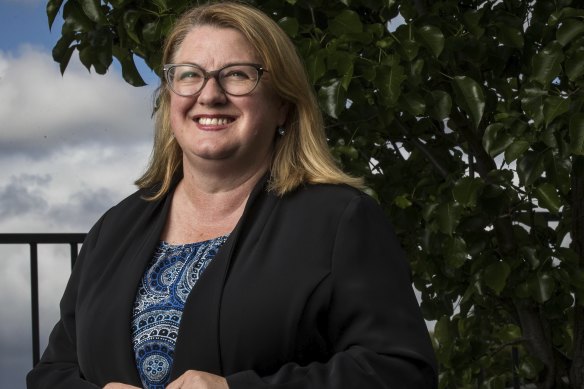By Robyn Grace
Some Victorian private schools are already breaching the threshold for the state government’s new payroll tax, but they won’t pay it until at least 2029 because they are not on the existing list of schools to be taxed.
The Andrews government has confirmed that those left off the initial list of 60 tax-paying schools will not be reassessed, despite confirmation from the sector’s peak body that other schools had already exceeded the income threshold of $15,000 per student.

Education Minister Natalie Hutchins.Credit: Darrian Traynor
“Schools currently declared exempt from payroll tax remain exempt until the next review of the threshold in 2029,” a government spokesperson said on Monday.
But new non-government schools opening between now and 2029 will also be assessed against the threshold, the spokesperson said.
The comments have revived calls from the sector to scrap the tax, which has been criticised as arbitrary and unfair since its surprise announcement in the May state budget.
The tax was originally planned to contribute $420 million towards covering the state’s COVID debts, but will reap $100 million less after the government lifted the threshold from $7500 to $15,000.
In June, Treasurer Tim Pallas and Education Minister Natalie Hutchins announced the list of 60 schools that would pay the tax, which comes into effect next July, in what they described as a bid to give certainty for future planning.
But the government’s comment on Monday shows the private school payroll tax will work differently to those in other industries, where the financial threshold is a trigger for deciding who must pay.
Amendments to the Payroll Tax Act 2007 don’t specify the threshold or the number of schools that will be affected, leaving those elements to ministerial discretion.
Jim Koutsokostas, a tax partner at commercial law firm Hall and Wilcox, said it was important any tax legislation was properly administered and consistent with the intent of the new measures, so there was certainty and fairness in applying the rules.
“This may end up in a two-class system and could introduce unfairness,” he said. “If a school meets the $15,000 threshold but is not then subject to the payroll tax system, that may put the select 60 schools at a disadvantage.”
Hamilton and Alexandra College principal Michael Horne, whose 450-student school in Victoria’s south-west is among the 60 liable for the tax, said the unfairness was compounded if other schools remained exempt until 2029.
“In future years, between two schools with exactly the same fee level, one may be subject to the tax while the other is not. That’s unfair on any measure,” he said.
Horne said his school charged about $21,700 for year 12 fees, but its average per student was just over $15,000.
Pallas said when he announced the threshold at the end of June there was “less than absolute purity in terms of the way that these arrangements were put in place”.
But the treasurer accepted that lower fee-paying schools would be challenged by the introduction of the charge.
Pallas said in June: “When you think about it, 60 schools only out of 660 [independent schools] that are effectively exempt, what that tells us is it’s those high fee-paying schools who are the ones who are doing the most substantial heavy lifting in terms of provision of this tax.”
The measure of “income per student” is based on fees, compulsory levies and other data from the federal Education Department’s financial questionnaire, which is not publicly available. Income is then divided by the number of funded enrolments.
But the list of non-exempt schools was based on 2021 figures. Independent Schools Victoria said other schools had already crossed the $15,000 threshold, a year before the tax came into effect.
Kew’s Andale School, a small suburban campus for children with special needs, is liable despite having just 22 students.
Independent Schools Victoria chief executive Michelle Green said schools were struggling with the tax’s arbitrary nature and the “extraordinary discretion the education minister has, to pick and choose who pays and who doesn’t”.
“Some schools, which have raised their fees since 2021 and currently reach the threshold are not trapped by the tax, while others are,” Green said. “It doesn’t make sense. Instead, it has created two classes of schools.”
She said the threshold was set until 2029, but schools had no idea what would happen at that point.
“This means schools, which are required by government regulation to have five-year financial plans, have no idea what their long-term tax liability will be, or even when they will be told. It’s a guessing game.”
Opposition education spokesman Matt Bach said the measure was “a botched process from start to finish”.
“I don’t think it’s fair that any school should have to pay this payroll tax. But it’s certainly not fair that the government continues to move the goalposts,” he said.
Public schools are already liable for payroll tax but non-government schools have historically been exempt due to their not-for-profit status.
Catholic Education Commission of Victoria executive director Jim Miles said he remained strongly opposed to the payroll tax.
“While the schools subject to payroll tax are now set until 2029, it continues to be unfair,” he said. “Unlike government schools, the new payroll tax is a real cost for non-government schools, not a circular payment within government.”
The Morning Edition newsletter is our guide to the day’s most important and interesting stories, analysis and insights. Sign up here.